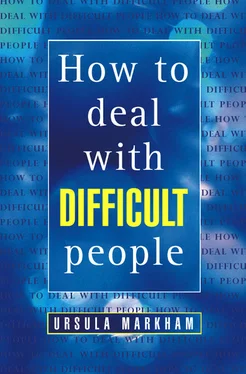Ursula Markham - How to Deal With Difficult People
Здесь есть возможность читать онлайн «Ursula Markham - How to Deal With Difficult People» — ознакомительный отрывок электронной книги совершенно бесплатно, а после прочтения отрывка купить полную версию. В некоторых случаях можно слушать аудио, скачать через торрент в формате fb2 и присутствует краткое содержание. ISBN: , Жанр: unrecognised, на английском языке. Описание произведения, (предисловие) а так же отзывы посетителей доступны на портале библиотеки ЛибКат.
- Название:How to Deal With Difficult People
- Автор:
- Жанр:
- Год:неизвестен
- ISBN:978-0-00-738171-5
- Рейтинг книги:4 / 5. Голосов: 1
-
Избранное:Добавить в избранное
- Отзывы:
-
Ваша оценка:
- 80
- 1
- 2
- 3
- 4
- 5
How to Deal With Difficult People: краткое содержание, описание и аннотация
Предлагаем к чтению аннотацию, описание, краткое содержание или предисловие (зависит от того, что написал сам автор книги «How to Deal With Difficult People»). Если вы не нашли необходимую информацию о книге — напишите в комментариях, мы постараемся отыскать её.
A concise, straightforward book on how to handle difficult people in your personal or professional life.
How to Deal With Difficult People — читать онлайн ознакомительный отрывок
Ниже представлен текст книги, разбитый по страницам. Система сохранения места последней прочитанной страницы, позволяет с удобством читать онлайн бесплатно книгу «How to Deal With Difficult People», без необходимости каждый раз заново искать на чём Вы остановились. Поставьте закладку, и сможете в любой момент перейти на страницу, на которой закончили чтение.
Интервал:
Закладка:
Once you have learned to reduce self-criticism and improve your self-image, you will be less likely to suffer from the otherwise damaging words and actions of difficult people. Also, because you have learned to understand yourself better, you may also be able to understand them. You may begin to see that something has made them the way they are. Once you can begin to feel sorry for someone, however dreadful he may be, he can no longer inflict harm on you.
As your confidence grows you will also be able to put into action the techniques you are going to learn in the rest of this book to help you deal with difficult people. You will know that you are likely to succeed in coping with them and that, even on the odd occasion when you do not succeed, you will have done your best and so will have no need to reproach yourself in any way at all.
CHAPTER TWO Styles of Behaviour
The majority of people with whom you come into contact, whether in your business or personal life, will exhibit one of three general styles of behaviour: they will be (mainly) either aggressive, submissive or assertive. If you are to be able to deal with people you need to be able to recognize these styles of behaviour and be armed with methods of minimizing their negative effect. An important part of doing this is making sure that you yourself are in the ‘assertive’ category.
Let’s have a look at the three basic types and see how to recognize them instantly:
The Aggressive Person
The aggressive person is the verbal bully, concerned only with satisfying his own needs, and frequently hurting other people in the process. (By the way, when I refer to ‘he’ ‘his’ or ‘him’ anywhere in this book please take it to mean either gender. No sexism is intended.)
The aggressive person enjoys the feeling of power that he thinks he has and the ability to make people rush about and do his bidding – but his enjoyment is often short-lived. He may never admit it but deep inside he knows that he is taking advantage of others who are either weaker than himself or in a position where they are unable to do anything about it – for example, when a manager is aggressive towards a very junior employee who is not able to retaliate without risking his job.
Convinced that he is the only one who could possibly be right in any situation and that the only needs that matter are his own, the aggressive person reminds others repeatedly of just how clever, strong or important he is. Just as physical bullying often hides a cowardly nature, this sort of boasting often masks feelings of inferiority or self-doubt. In addition to persuading others of his superiority, the aggressive person is also trying desperately to convince himself.
You will often find that the aggressive person is also a lonely person. His behaviour tends to drive others away in both his business and personal life. Because he has constantly to reassure himself and everyone around that he is the best, the most interesting and the most intelligent, he is excessively critical of everyone else. It is a great ego-booster for him to think that everything that goes wrong is someone else’s fault, but it does not make him very popular. Although he may feel a desperate inner need to have friends, he is unlikely to admit this; you have to treat friends as equals and he cannot allow himself to admit that anyone is worthy of such consideration.
Someone who is aggressive often has a great deal of energy and vitality. If only he could learn to harness that energy and use it positively, all would be well. Sadly, he tends to use it in a destructive way rather than a constructive one. Some people mistake aggression for strength and feel that if they display any other type of behaviour they will be taken for weaklings or will seem as if they do not know their own minds.
When aggression is taken to extremes it becomes violence (physical aggression). However, we will concern ourselves only with the verbal aggressor, with whom most of us are more likely to come into contact.
Not only does the aggressive person not really like himself, he also has a negative effect on all the people around him. These others may feel angry or frustrated because, while only too aware of the unfairness of his attitude, they are either powerless to do anything about it or resent having to waste their time and energy trying to defend themselves against his unjust accusations. This waste of energy, coupled with feelings of helplessness, is quite exhausting and often causes the aggressor’s ‘victims’ a great deal of stress and tension.
Even if those who come into the line of fire know perfectly well that the aggressor’s accusations and comments are unjust and uncalled for, they will not be able to help feeling hurt and even humiliated by them. No one likes to be made to appear foolish or to be corrected in front of others – and of course this is just what the aggressive person does. It adds to his sense of power if as many people as possible can hear him exerting his authority and putting down some other ‘inferior’ being.
Because anticipation of an event is often more stressful than the event itself, those who have to come into frequent contact with an aggressive person may feel that they are living on the edge of a volcano, always waiting for the next eruption. At the least this can cause them to feel anxious or inhibited; at worst it can lead to excess stress which in turn can bring about physical or mental illness. But of course the aggressor rather likes the fact that all around him are waiting for the other shoe to drop. It adds to his sense of power and authority.
Taking all this into account, it is hardly surprising that everyone tends to leave the aggressive person alone if they possibly can. This increases his feelings of isolation and of being ‘different’ or ‘special’, so he is likely to act in an even more aggressive fashion, thus perpetuating the cycle.
Anyone who comes into frequent contact with an aggressor will find no difficulty in identifying him at a glance, but here are some ‘give-aways’ in both verbal and body language which will point him out immediately even to a relative stranger.
Verbal Language: The Aggressive Person Will Say Things Like:
You’d better …
You’re hopeless …
You must …
Do what I tell you …
I want you to …
Get on with it!
Body Language
Stands still
Has a stiff, rigid posture
Keeps arms folded
Shouts
Points finger
Stabs with finger
Bangs desk or table
The Submissive Person
In complete contrast, the submissive person is one who tends constantly to sacrifice his own needs in favour of other people’s. He is therefore easily put upon by others – even those who are not by nature aggressive. It is just that the submissive person seems to encourage this attitude in those with whom he comes in contact.
In former generations it was believed that women were ‘supposed to’ behave in a submissive way; it is only comparatively recently that it has become acceptable for a woman to be assertive or competitive. Progress in this direction has been impeded, however, by men in certain organizations who are old enough or bound enough by tradition to cling to the old ideas of ‘a woman’s place’. In such companies it is extremely difficult for a woman, however talented, efficient and conscientious to reach the top. Presumably, however, as the members of this old hierarchy retire women will have more of an opportunity to share professional responsibilities with men.
The submissive person suffers greatly from feelings of insecurity and inferiority. His self-esteem is non-existent and he has no confidence at all in himself or in his abilities. Every time he comes into contact with an aggressor his feelings of inferiority are reinforced. He tends to accept criticism without stopping to question whether it is justified or not.
Читать дальшеИнтервал:
Закладка:
Похожие книги на «How to Deal With Difficult People»
Представляем Вашему вниманию похожие книги на «How to Deal With Difficult People» списком для выбора. Мы отобрали схожую по названию и смыслу литературу в надежде предоставить читателям больше вариантов отыскать новые, интересные, ещё непрочитанные произведения.
Обсуждение, отзывы о книге «How to Deal With Difficult People» и просто собственные мнения читателей. Оставьте ваши комментарии, напишите, что Вы думаете о произведении, его смысле или главных героях. Укажите что конкретно понравилось, а что нет, и почему Вы так считаете.












